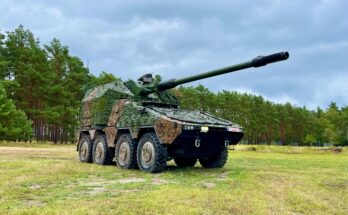In a step announced on December 9, three nations – Italy, Japan, and the United Kingdom – announced a joint agreement on a trilateral future fighter development project called the Global Combat Air Program (GCAP). The initiative essentially merges two existing programs – Japan’s FX new-generation fighter and the Anglo-Italian Future Combat Air System (FCAS), better known as “Tempest” – into one.
The agreement provides all three parties with economies of scale and an opportunity to share technology while developing a next-generation air combat system.
While the UK led Tempest and Japan drove F-X, the GCAP will have no lead nation or company. Programme will be a 'partnership of equals', with @BAESystemsAir heading up development on behalf of the UK, @Leonardo_live for Italy, and @MHI_Group for Japan. 2/7 pic.twitter.com/QI0AQb67pY
— Gareth Jennings (@GarethJennings3) December 9, 2022
One area of collaboration, which was already underway, involved a joint combat engine development program launched between British engine maker Rolls-Royce and IHI Corporation on December 22, 2021, while another between Leonardo and Mitsubishi Electric covered the Jaguar advanced radar demonstration project undertaken to support the British Tempest and Japan’s F-X development work.
The two parallel fighter programs – Tempest and F-X – shared similar development timelines; therefore, the alignment is a natural one.
Japan’s F-X program has been spearheaded by Mitsubishi Heavy Industries (MHI), with subcontractors including IHI, Kawasaki Heavy Industries (KHI), Subaru, Toshiba, NEC, Fujitsu, and Mitsubishi Electric.
The goal for Japan in launching F-X has been to develop and build a next-generation fighter to replace the legacy MHI F-2 multirole combat aircraft fleet sometime in the mid-2030s, while enabling its aerospace industry to retain and grow its aviation technological know-how.
On the British side, the Tempest is the manned aircraft component of the FCAS and is touted as a sixth-generation fighter. The primary industrials partaking in the program are BAE Systems (leading the British developmental side), Leonardo (heading development for Italy), MBDA and Rolls-Royce.
The British goal is to have the new combat capability ready for entry into service in the mid-to-late 2030s, when it would begin replacing the Royal Air Force’s Eurofighter Typhoon fleet.
For Italy, Tempest/FCAS represents one of the country’s priority defense programs, with the future capability to serve – as in Britain – as a replacement for its air force’s Eurofighter Typhoon fleet.
Italy has planned on investing at least EUR2 billion ($2.1 billion) in the Tempest development program between 2021 and 2035, while on the British side, the cost projection for Tempest/FCAS is currently estimated at GBP9.46 billion ($11.6 billion), per the U.K. government’s Infrastructure and Projects Authority (IPA), which published its findings on July 15, 2021.
Japanese estimates for F-X have ranged as high as $40 billion.
The huge costs of developing a modern combat aircraft type alone mean that finding partners to split costs, reduce risk, create economies of scale during production, and enable potential export orders down the line becomes the most logical solution.
Developing and producing a highly sophisticated combat aircraft system for orders of just 91 fighters in a like-for-like replacement of the Japan Air Self-Defense Force’s F-2, or 96 to replace Italy’s Eurofighters, means that unit costs would skyrocket exponentially for a one-off capability. Without export orders to reduce production costs or partners to share in development funding and reduce technological risks, such an investment becomes fiscally untenable.
While the logical assumption is that Japan would look to the U.S. – its closest strategic partner and principal supplier of advanced weaponry – to cooperate with it on the F-X project, past issues with sharing key technological information left Tokyo seeking a more open, reliable relationship on an equal level. With Britain already cooperating with Japan on the research and basic design development of the F-X’s engine and radar, London becomes the logical choice.
The odd party out in this arrangement is Sweden, which had opted for more of an “arms-length” observer status when defense ministers of the three countries inked a trilateral Memorandum of Understanding (MoU) regarding development of the Tempest future fighter on December 21, 2020.
Sweden began distancing itself from the program, as its focus remained on advancing its Gripen NG (New Generation, better known as the Gripen E) fighter, though partnership dialogue is said to be continuing.
Nonetheless, the addition of Japan is a boon to the Anglo-Italian effort, providing it with a partner featuring one of the world’s largest economies, an advanced fighter requirement that fits the shared timeline, and a desire to increase its aerospace technological edge.
In short, the two fighter initiatives already put into motion by Britain and Japan complement each other and could eventually make way for a truly viable future combat air system that may prove competitive on the global market.
Dan Darling is Forecast International’s director of military and defense markets. In this role, Dan oversees a team of analysts tasked with covering everything from budgeting to weapons systems to defense electronics and military aerospace. Additionally, for over 17 years Dan has, at various times, authored the International Military Markets reports for Europe, Eurasia, the Middle East and the Asia-Pacific region.
Dan's work has been cited in Defense News, Real Clear Defense, Asian Military Review, Al Jazeera, and Financial Express, among others, and he has also contributed commentary to The Diplomat, The National Interest and World Politics Review. He has been quoted in Arabian Business, the Financial Times, Flight International, The New York Times, Bloomberg and National Defense Magazine.
In addition, Dan has made guest appearances on the online radio show Midrats and on The Media Line, as well as The Red Line Podcast, plus media appearances on France 24 and World Is One News (WION).




